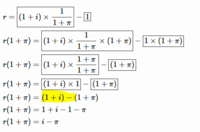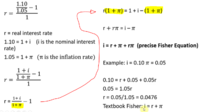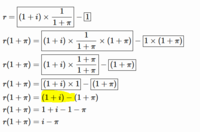You are using an out of date browser. It may not display this or other websites correctly.
You should upgrade or use an alternative browser.
You should upgrade or use an alternative browser.
Wrong proof?
- Thread starter nosit
- Start date
Dr.Peterson
Elite Member
- Joined
- Nov 12, 2017
- Messages
- 16,864
I think you are forgetting to multiply the entire RHS, and just multiplying the first term. Here are the details:
[MATH]r=\frac{1+i}{1+\pi}-1[/MATH]
[MATH]r(1+\pi)=\left[\frac{1+i}{1+\pi}-1\right](1+\pi)[/MATH]
[MATH]r(1+\pi)=\left[\frac{1+i}{1+\pi}\right](1+\pi)-1(1+\pi)[/MATH]
[MATH]r(1+\pi)=\frac{(1+i)(1+\pi)}{1+\pi}-(1+\pi)[/MATH]
[MATH]r+r\pi=(1+i)-(1+\pi)[/MATH]
[MATH]r+r\pi=1+i-1-\pi[/MATH]
[MATH]r+r\pi=i-\pi[/MATH]
Thank you @Dr.Peterson

When you multiply the RHS by [MATH](1+\pi)[/MATH] I wonder if you were thinking that [MATH]\frac{1+\pi}{1+\pi}[/MATH] gives you 1 which is ADDED to the end giving 1+i - 1 +1
But the 1 is actually multiplying the (1+i)
[MATH]r= \boxed{(1+i)\times\frac{1}{1+\pi}} - \boxed{1}\\ r(1+\pi)=\boxed{(1+i)\times\frac{1}{1+\pi}\times(1+\pi)} - \boxed{1\times(1+\pi)}\\ r(1+\pi)=\boxed{(1+i)\times\frac{1+\pi}{1+\pi}} - \boxed{(1+\pi)}\\ r(1+\pi)=\boxed{(1+i)\times 1} - \boxed{(1+\pi)}\\ r(1+\pi)=(1+i) - (1+\pi)\\ r(1+\pi)=1+i - 1-\pi\\ r(1+\pi)=i-\pi[/MATH]...
I was wondering if mathematically a distributive to the other side is allowed (where I highlighted in yellow). Is it?
It does not seem to be, because the result would be different, it would be:
-1-i+1+pi
pi-i
which is different...

I think you mean, can they commute? The answer is no, because subtraction is not commutative:
[MATH]a-b\not\equiv b-a[/MATH]Addition is commutative, so you could think of it as:
[MATH]a+ \text{-}b \equiv \text{-}b+a[/MATH]i.e. [MATH](1+i)+\text{-}(1+\pi)=\text{-}(1+\pi)+(1+i)[/MATH]
Two things
The demonstration is unnecessarily obscure.
[MATH]r = \dfrac{\dfrac{1 + i}{1 + \pi} - 1}{1} = \dfrac{1 + i}{1 + \pi } - 1 = \dfrac{1 + i - (1 + \pi )}{1 + \pi} \implies [/MATH]
[MATH]r = \dfrac{i - \pi }{1 + \pi}.[/MATH]
Now it is easy to see
[MATH]r(1 + \pi)= \dfrac{i - \pi}{1 + \pi} * (1 + \pi) \implies r + r \pi = i - \pi \implies i = r + \pi + r \pi.[/MATH]
Second, if r and pi are small, r times pi is negligible.
[MATH]i = 0.1 \text { and } \pi = 0.05 \implies r = \dfrac{0.1 - 0.5}{1.05} \approx 0.047619.[/MATH]
[MATH]0.05 * 0.047619 = 0.00238095, \text { just over 2 basis points.} [/MATH]
Unless we are dealing with very rapid inflation, the error in the text book version is not worth bothering about because it is swamped by the uncertainty in the expected inflation rate.[/MATH]
The demonstration is unnecessarily obscure.
[MATH]r = \dfrac{\dfrac{1 + i}{1 + \pi} - 1}{1} = \dfrac{1 + i}{1 + \pi } - 1 = \dfrac{1 + i - (1 + \pi )}{1 + \pi} \implies [/MATH]
[MATH]r = \dfrac{i - \pi }{1 + \pi}.[/MATH]
Now it is easy to see
[MATH]r(1 + \pi)= \dfrac{i - \pi}{1 + \pi} * (1 + \pi) \implies r + r \pi = i - \pi \implies i = r + \pi + r \pi.[/MATH]
Second, if r and pi are small, r times pi is negligible.
[MATH]i = 0.1 \text { and } \pi = 0.05 \implies r = \dfrac{0.1 - 0.5}{1.05} \approx 0.047619.[/MATH]
[MATH]0.05 * 0.047619 = 0.00238095, \text { just over 2 basis points.} [/MATH]
Unless we are dealing with very rapid inflation, the error in the text book version is not worth bothering about because it is swamped by the uncertainty in the expected inflation rate.[/MATH]


